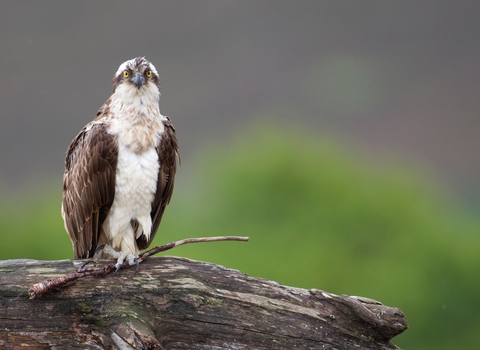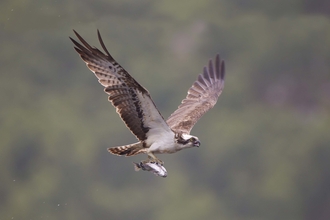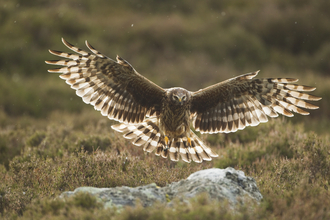The osprey
Ospreys are awe-inspiring birds. Look out for them from mid-March through to the end of the summer as they wrestle a large fish from a lake or ward off intruders from their nest, before they make the remarkable 3,000 mile migration to sub-Saharan Africa. Having been driven to extinction through persecution in the Victorian era, they have made a remarkable comeback and The Wildlife Trusts are working across the UK to help these amazing birds, and provide people with opportunities to see and enjoy them.
Once just a single pair of ospreys survived in Scotland: now they are back
Find ospreys near you
The reserves listed here have hides overlooking active osprey nests, with telescopes available for a closer look and volunteers on hand to tell you more about the birds. For something a bit different, join an osprey cruise at Rutland Water on board the Rutland Belle. There is a good chance of seeing fishing ospreys from the boat and you can enjoy wonderful views of the area at the same time.
Cumbria Wildlife Trust
Cumbria Wildlife Trust’s work to restore Foulshaw Moss Nature Reserve has encouraged ospreys to visit since the late 1990s. Improvements to the habitat and the installation of a number of nesting platforms now provides the ideal location for ospreys to nest and to breed, and for many other species too. In 2014, for the first time, a pair of osprey successfully bred and reared three healthy chicks. Foulshaw Moss is next to the Kent Estuary as well as near the rivers, lakes and tarns, giving the birds options of where to fish - a little like us having options of where to shop.
With more hard work and more habitat improvements Cumbria Wildlife Trust hopes that ospreys will become a more common sight across the whole of the UK. If you time your visit to the nature reserve when staff are present there may be a telescope focused on the nest so you can get a good view. Visit their website to view the osprey live cam, or sign up to receive osprey email updates.
Cumbria Wildlife Trust is also appealing to people for binoculars (new and used) so that we can provide them at the reserve for people to use to get a closer look at the ospreys.
Essex Wildlife Trust
Essex Wildlife Trust is delighted to be working with Essex & Suffolk Water at Abberton Reservoir to provide four osprey nesting platforms at various locations around the reservoir. The hope is that young ospreys will find the platforms irresistible and stop on migration – and, over time, perhaps stay for a summer and even breed, making Abberton their home, year in year out. The platforms were erected in March. Now, it’s a case of wait and see. The hope is that this is just the first phase of an expanding project.
Leicestershire & Rutland Wildlife Trust
Rutland Water is home to the first ospreys to breed in England for 150 years thanks to a translocation programme. The ospreys are observed from their arrival from Africa in spring through to their autumn migration. It’s a ground-breaking project in many ways, and over 250 chicks have successfully fledged at the site since 2001. One pair nests on the Manton Bay nest site near the Lyndon visitor centre, where you can get great views of the birds during the summer.
You can follow the Rutland osprey story on their social media accounts, watch the live nest webcam and get involved with World Osprey Week towards the end of March, providing an exciting opportunity for everyone to learn about the amazing lives of the ospreys. There are lots of free learning resources available on the website, including an opportunity to volunteer with the osprey monitoring project, help out at the centre or donate to the project to help ensure the success of these amazing birds in the future.
All information on the project can be found here including the amazing history of the project and the most recent 250th successfully fledged osprey chick.
Follow the osprey story on Leicestershire and Rutland Wildlife Trusts Facebook, Instagram, X and YouTube osprey channels.
Montgomeryshire Wildlife Trust
The Dyfi estuary in Powys has been a regular stopping off point for migrating Scottish ospreys for many years. In 2007, Montgomeryshire Wildlife Trust built a nesting platform at their Cors Dyfi reserve in the hope of attracting some of these passers-by to stay, and amazingly the very next year a male bird did just that. “Monty”, and his partner, Glesni, became stars of the BBC's Springwatch series, and breed on Cors Dyfi Reserve. The Dyfi ospreys are one of four pairs that breed in Wales and since 2011, they have produced 13 chicks.
The Dyfi Osprey Project has a visitor centre and a new 360 Observatory less than 200m from the nest - ideal for close-up views and photography, both joined by 600m of extra-wide boardwalk through the stunning reserve. Over 100 volunteers donate their time to the Dyfi Osprey project and someone is always on hand to help our visitors get the most from their visit. Four HD cameras monitor the nest 24/7 and there is a Live Streaming and Chat facility here. You can also follow the Dyfi Osprey Project on Facebook and Twitter.
Northumberland Wildlife Trust
For many years ospreys were seen passing through Kielder Forest, always on the way north to more long-standing nesting sites in Scotland. As more and more of the best nesting spots were taken up, it was just a matter of time before they stayed south of the border. To encourage this, the Forestry Commission installed a number of platforms around the Forest after a failed attempt to nest by two young birds in 2008. This paid off, as following an absence of about 200 years in Northumberland, ospreys returned to nest at Kielder in 2009.
Since 2009 a watch point has helped show off these wonderful birds to the visitors who make the trip to Kielder Water & Forest Park. The reserve is lucky to have a very rare occurrence of two breeding males being brothers born in different years and migrating separately but both ending up in Kielder. Three of the healthiest birds are tagged with a satellite transmitter to track their progress back to Africa. Follow their progress on the Osprey Watch blog.
Northumberland Wildlife Trust run Osprey Watch from a viewpoint at Kielder Waterside, giving visitors an opportunity to see and learn more about the Kielder osprey population while ospreys perch on a platform at Bakethin reserve nearby, providing fantastic views. The watch is open from around the time the eggs are due to hatch until about the time the young fledge. Volunteers equipped with telescopes, are available at Leaplish Waterside Park to help the public view the birds on Nest 1 as this is the only nest that can be seen from this point. Keep an eye on their events page for other events.
Scottish Wildlife Trust
The Scottish Wildlife Trust’s Loch of the Lowes Wildlife Reserve has been home to breeding ospreys since 1969. Osprey fever grips the Scottish Wildlife Trust Loch of the Lowes team at from the moment their ospreys return to nest and their website buzzes with sightings and discussion of osprey parental techniques. They have even named one of their trees after 'Lady', a magnificent osprey who nested in it for 24 years, raising 50 chicks, until 2015. A new female osprey arrived in 2015, now breeding there in her place.
North Wales Wildlife Trust
The Llyn Brenig Osprey project began in 2013 when the first nests were built using recovered wood. Today Ospreys have moved in! With a telescope, you can see the pair from a safe distance from April to the end of August. Staff and telescopes will be on hand throughout the nesting!
What to look for
As with any wildlife experience, patience is needed, but a quiet wait can be rewarded by the sight of an osprey fishing with talons outstretched or shepherding intruders away from their high nests. With a wingspan of 1.5 metres ospreys are one of our largest birds of prey and the only kind that eats fish exclusively. Nothing short of spectacular in flight, its long, angled wings show off white linings and a black patch near its wrist. It can sometimes be mistaken for a gull at a distance.
Systematic persecution and low breeding numbers drove the osprey to extinction in England for some 150 years. Thankfully numbers picked up in the osprey’s Scottish stronghold and the species gradually spread south. In 1996 they were reintroduced to central England and the burgeoning population at Rutland Water spread to Wales. There are now close to 300 breeding pairs in the UK – the majority are in Scotland while numbers in England and Wales are on the up thanks to the efforts of Wildlife Trusts.
If you can't get to an osprey site
You can always watch their activity from the comfort of your home on one of our osprey webcams!
More wildlife experiences
From seeing colourful wildflowers to spotting magnificent birds of prey, we can help you get closer to wildlife across the UK.







